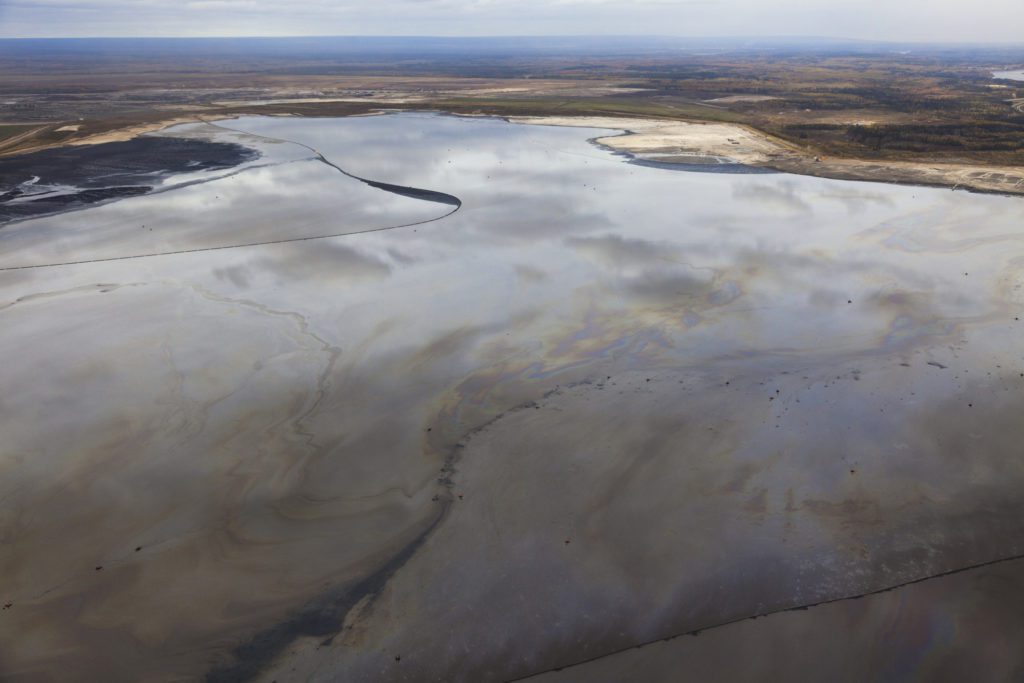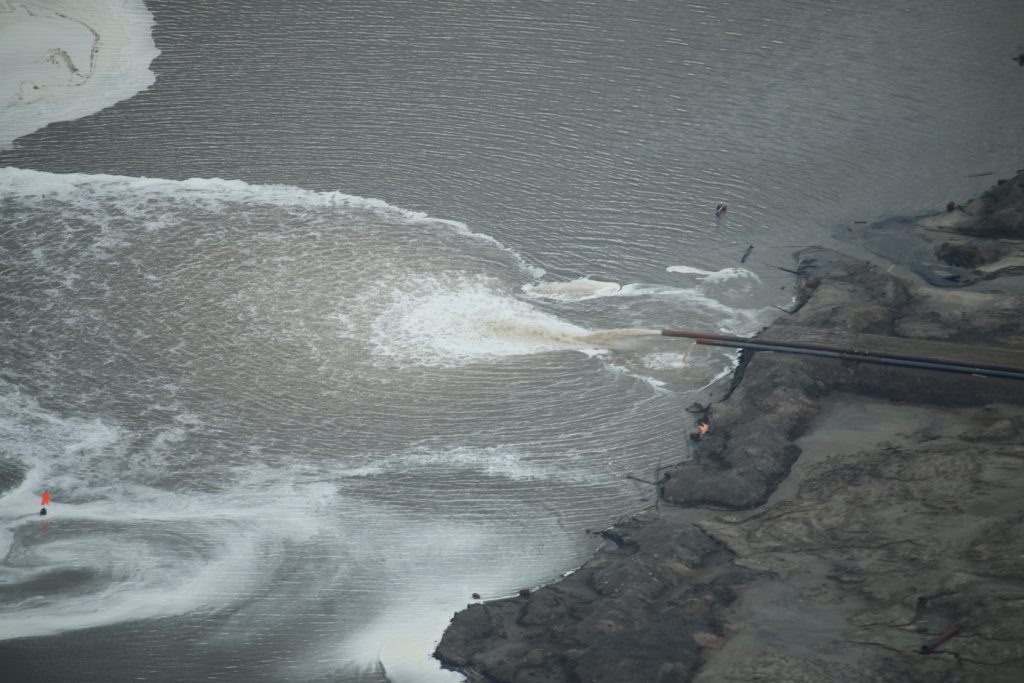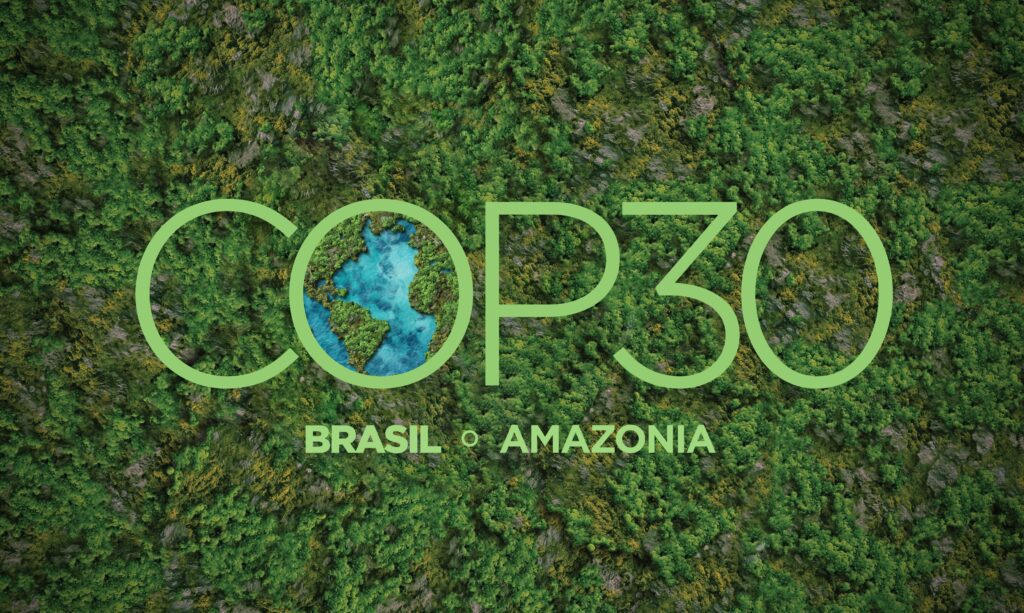When oil companies started mining the tar sands for bitumen at a large scale in the 1960s, they quickly realized they’d also be producing huge volumes of toxic waste. The industry pumped this waste into what they called a “tailings pond”, but is actually just a hole in the ground without any lining to protect the surrounding environment. Then they waited, hoping the problem would go away. It didn’t.
Instead, over a trillion litres of toxic waste has accumulated in huge industry-made lakes, with no clear solution to clean it up. Despite decades of advocacy from local Indigenous communities, companies have not been forced to clean up their mess. However, these huge lakes are costly to maintain, and the risks they pose to human health and the environment have attracted national and global attention, much to the industry’s dismay.
In response, oil companies proposed a “solution”: treating the waste and releasing it into the river. Local Indigenous communities and conservation experts immediately opposed the idea, because the industry provided no evidence the waste could be treated to safe levels. Now, a group of academics have published a peer-reviewed paper in the journal Evidence-Based Toxicology which expresses their concerns with the idea and recommends what a safe path forward looks like. The authors are experts in human health, risk assessment, biology, toxicology, and environmental policy.

Here’s my TL/DR version of their article – trust me, this is the short version!
There is so much we don’t know about the oil sands’ toxic tailings
Oil sands process water, the technical name for the oil industry’s toxic waste, contains thousands of chemicals including benzene and mercury, as well PAHs, which are known carcinogens, and naphthenic acids, which we know disrupt reproductive systems in animals. We have evidence of how dangerous these chemicals are on their own, but we are still largely in the dark about how they interact with each other – especially if they reach a different environment, like the human body!
There is also an “information asymmetry” between oil companies, who know what they are putting in the environment, and communities who are largely in the dark. A jarring example of that was when it was revealed that Imperial Oil knew that its Kearl mine had been leaking toxic waste for months and didn’t inform local communities.
These uncertainties, information gaps and unequal distribution of resources should be taken into account when thinking of solutions.
Take Action: Ensure companies clean up their toxic tailings!
The way we deal with tailings now is unacceptable
In the tar sands, companies are legally required to reclaim the area disturbed once they are done using it, meaning they have to restore the area to a state similar to how they found it.
Yet, companies currently decide the criteria for what counts as reclaimed, and the Alberta Energy Regulator approves it. It’s like letting a fox guard the hen house! There is no requirement for these criteria to include measures to reduce or eliminate toxic chemicals in reclaimed areas, and in fact, all companies currently have criteria that only consider what the reclaimed surfaces look like and if they seem to function as before.. In short, they are more concerned about whether you can drive over the “reclaimed” area than whether your kids can play nearby.
Even with these weak criteria, only 0.1% of the area disturbed by oil sands mining has been certified as reclaimed by the Alberta Energy Regulator, and none were areas containing tailings.
Any solution to the tailings problem must put a stop to the contamination
Oil companies are focused on finding a “solution” to the tailings problem which minimizes what it costs them. Impacted communities, on the other hand, are interested in minimizing risks to their health and livelihoods. There needs to be an agreement on the final goal of reclamation before the work starts.
In the article, experts propose that one of the goals of reclamation should be to guarantee “no further exposure” to chemicals of concern, meaning the clean-up methods must guarantee that the environment or communities would not be exposed to any additional dangerous chemicals. While this might sound obvious, it’s not the norm. In most industries, the rules allow for some exposure, as long as it stays under a level considered to be safe, like the concentration of salt in our drinking water.
In the case of the oil sands, that’s not enough, say the experts. Here’s why:
- There is a high level of uncertainty about the risks posed by tailings waste, because of the interactions between the many substances in the mix. This means we don’t have the evidence to say what’s a safe level of exposure to this toxic cocktail.
- The volume of waste is so large that even a small concentration of toxins would, given the trillions of litres that could be released, end up creating a high level of exposure.
- The ecosystems and the Indigenous communities downstream of the oil sands have already been exposed to high levels of toxins, both from five decades of oil sands mining and from other industries further upstream. Since we don’t know just how exposed they’ve been, they might already be way past what’s considered “safe” for a certain substance, so any additional exposure could be disastrous.
For example, if this standard is applied to the “treat and release” method of eliminating tailings, governments would closely monitor the environment in which the release is happening. If there was any measurable increase in the levels for any of the substances of concern, even if the concentration is still under the amount considered “safe”, the release of tailings would have to stop immediately. Companies would have to revisit their treatment method and show they’ve addressed the issue before being able to move forward.

Truth and transparency are necessary to move forward
The authors highlight that it should ultimately be up to the Indigenous nations who are living with the consequences of the contamination to make decisions about what they want to see happen next.
Still, they provide recommendations for what governments must do, or force companies to do, to put a stop to the environmental injustice in the tar sands:
- Provide a complete picture of the risks posed by the toxic waste, including investigating the toxicity of the whole mixture, not just the individual parts.
- Regardless of the technical method chosen for tailings clean up, governments should require companies to prove they can guarantee “no further exposure” to toxic chemicals.
- Establish a website which shows in real-time any data we have about what is in the tailings, what leaks or other incidents are happening, what exposure we already know of, and other crucial information that allows health professionals to understand the risk the communities face at any given time.
- Charge the companies whose leaking tailings violate Canada’s environmental laws, such as the Fisheries Act, to put a stop to the contamination and ensure there are consequences for the companies who pollute.
You can also take action to ensure companies clean up toxic tailings. Sign our letter here.










